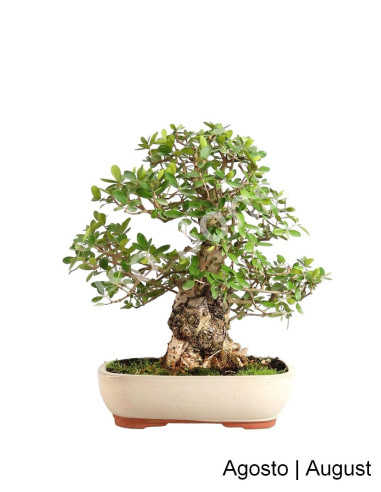- -10%
Zambujeiro - Oliveira Brava - Bonsai 32 Years
Species from the Mediterranean area (Portugal/Greece/Spain/Italy), belong to the family of Oleaceas.
Olea Sylvestris, known as Zambujeiro, is slow-growing, persistent, oval, and very small size when compared to Oliveira.
It is resistant and well adapted to our climate, has a natural ability to compact the leaf and thicken the base of the trunk (Nebari) that makes it one of the Bonsaistas' favorites.
Zambujeiro Bonsai is an outdoor plant.
Common Name: Oliveira
Scientific name: Olea europea
Characterization: From the Mediterranean area (Portugal/ Greece/Spain/Italy), it belongs to the family of Oleaceas.
Medium-sized tree and slow growth, persistent leaf and oval of gray green tones.
There is a brave variety, the Zambujeiro, also greatly appreciated in Bonsai by the small size of the leaf, and stiffness of the trunk that allows to make Jin and Shari (dead wood), this variety does not fructify.
Location: Outside, where take 2 to 3 hours of direct sun per day (ideal in the morning or late afternoon), protected from strong winds and frosts.
Water: To water abundantly the earth until a lot of water goes out through the drain holes in order to moisten evenly the soil, always above never by immersion, with a fine drain waterer.
Tips on watering, see technical data collection.
Let dry slightly the surface layer of the soil between each watering (to confirm if the plant already needs water, touch the earth with the fingers).
If you have a dish under Bonsai, never leave any water in it (to prevent the roots from rotting).
There is no advantage in spraying the leaves, just do it in the days when it adds up and if the fertilizer goes for foliar application, but ensure that they arrive dry at night to avoid fungi.
Nutrition: From February to October, with a base plan composed of a complete fertilizer (Fertil Bonsai Humic, or Green & Gold Bonsai Organic or Biogold), and a biostimulant (Bio Bonsai Activ), can still be linked with other products in our range.
Detailed information on how to combine these products the rest of our range, or for a more specific nutrition plan, see complete nutrition plan technical sheet.
Poda: The pruning should be made by allowing the plant to grow 5 to 6 pairs of leaves, then cut by the original form. Unfortunately this method normally eliminates floral gums.
We can after winter give a formation pruning and let the branches widen a little so that the flowers appear, only then cutting above them.
Tips on pruning, see the technical sheet pruning and defoliation.
Transplant: With Terra Bonsai Folhosas in February. We must rot strong and partially defoliate if necessary.
Details about transplantation, post transplantation and specific fortifiers that you can use refer to repotting technical sheet.
Scratch: It can be done throughout the year.
Indications on padding, see wiring technical sheet.
- Habitat
- Outdoor
- Sheet Type
- Persistent
- Species
- Zambujeiro
- Origin
- Luso-Bonsai (PT)




































